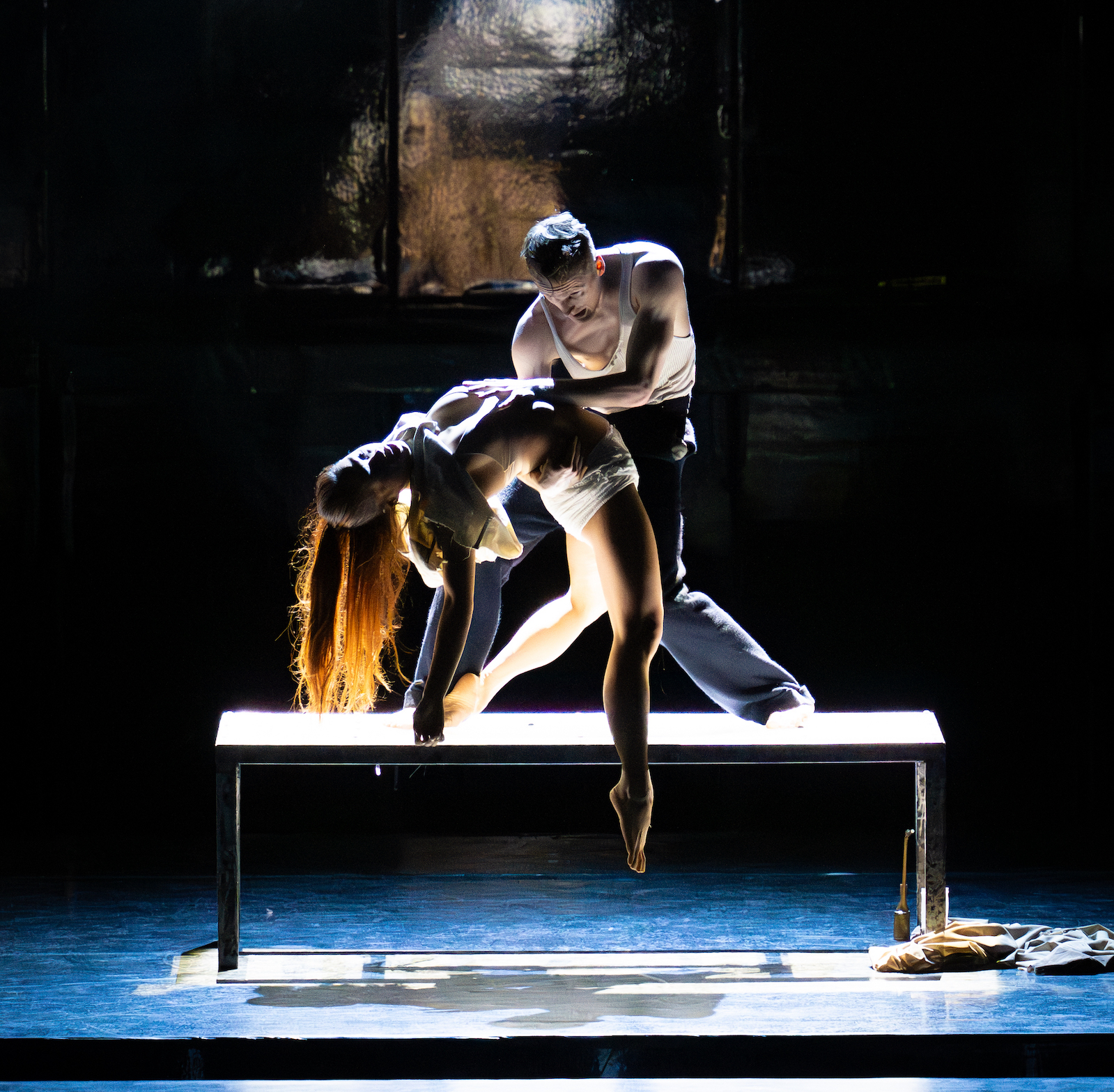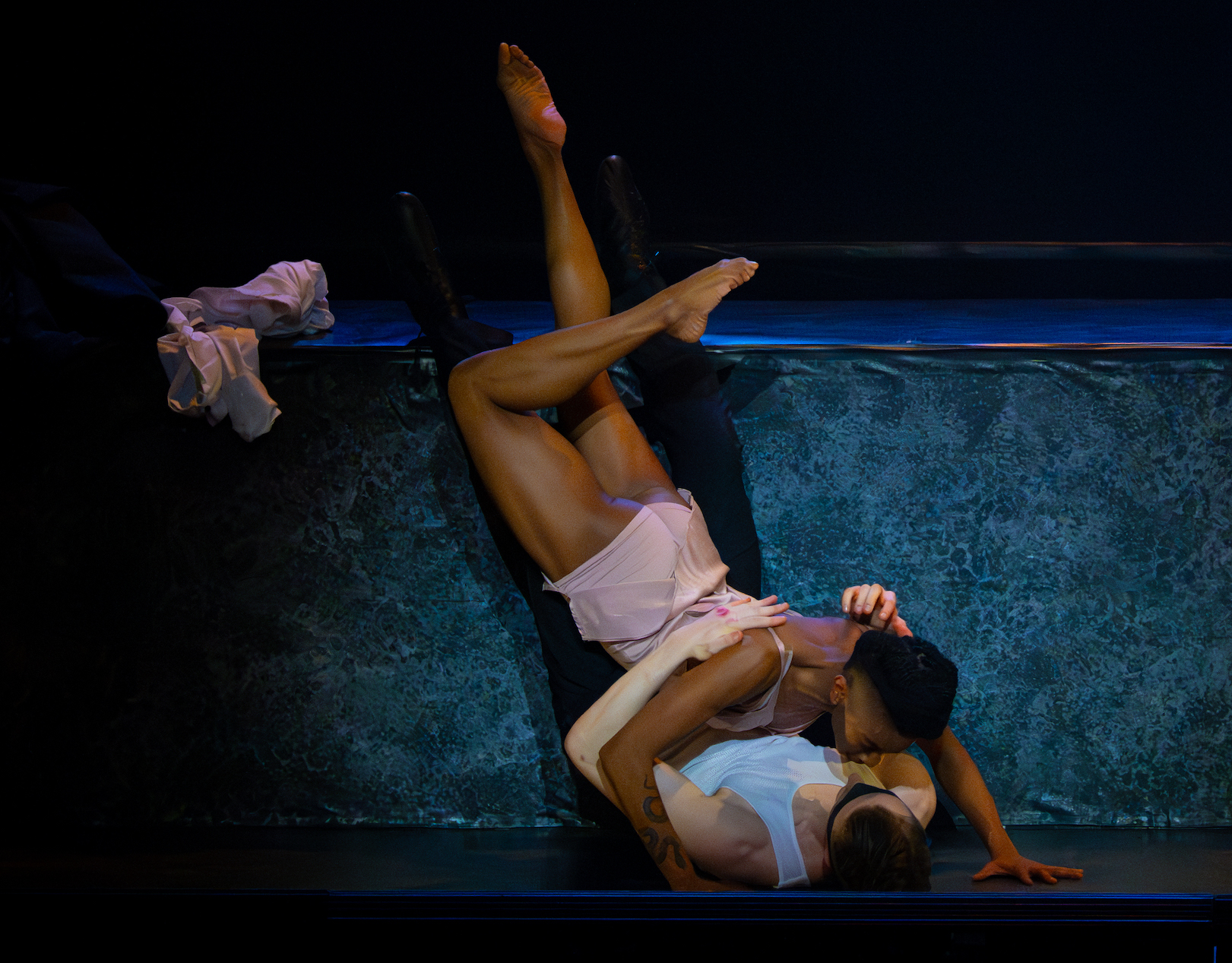Peaky Blinders: The Redemption of Thomas Shelby, Rambert, Sadler's Wells review - exciting dancing, if you can see it | reviews, news & interviews
Peaky Blinders: The Redemption of Thomas Shelby, Rambert, Sadler's Wells review - exciting dancing, if you can see it
Peaky Blinders: The Redemption of Thomas Shelby, Rambert, Sadler's Wells review - exciting dancing, if you can see it
Six TV series reduced to 100 minutes' dance time doesn't quite compute

If you have never watched a single episode of the BBC period gangster drama Peaky Blinders, I am not sure what you would make of Rambert’s two-act ballet version. I have watched all six series, and I still left confused.
Confused, but also impressed by the five-star standard of the dancing, by the inventive stage pictures created by designer Moi Tran and by the three onstage musicians. Led by lead guitarist/vocalist Mitchel Emms, this trio blast out a score specially written for the piece by Roman GianArthur, alongside tracks featured on the TV show by Radiohead, Frank Carter and the Rattlesnakes, Laura Mvula, Black Rebel Motorcycle Club and, best of all, Nick Cave and the Bad Seeds’ totemic “Red Right Hand”, the track that memorably opened the show’s first episode.
One key problem with the piece is that its creators, the TV series' writer Steven Knight and Rambert's artistic director Benoit Swan Pouffer, attempt to scrunch too much into its 100-minute span: four whole series’ worth, 24 hours of transmission time by my reckoning. We meet the Shelbys in the First World War trenches, where Tommy (Conor Kerrigan, pictured below with Hannah Hernandez) and two of his brothers, Arthur (Dylan Tedaldi) and John (Tom Davis-Dunn), have been fighting until they are “dead inside”, as a voice-over from the late Benjamin Zephaniah – who played a priest called Jeremiah Jesus in the TV series – informs us. Dialogue from the TV series featuring Cillian Murphy, Helen McCrory, Paul Anderson and Tom Hardy also wafts in and out, distorted and echoing so that it too isn’t totally clear.
We go through a succession of scenes where the brothers, plus sister Ada (Adel Balint) and Aunt Polly (Simone Damberg Würtz) and their friend Barney (Max Day), join forces on their patch in Birmingham, ridding it of the grotesque foreman at the foundry (a fat-suited Coke Lopez de la Madrid), and then start ousting other local gangs to gain control of the lucrative track betting system. As Tommy prospers, he attracts deadly rivals, and two personal tragedies lead him to opium dens and oblivion. Until, that is, he decides to live again, as Zephaniah’s on-off narration points out, and the gang reunites for a defiant finale.
 The piece actually begins with what is probably its quietest moment, as a kilted Joe Downard toting his electric cello walks into view playing a Celtic-sounding melody, a tribute to the Shelbys’ Irish traveller roots, presumably. The other musicians are swathed in darkness, only the blond hair of Emms making a dent in the gloom.
The piece actually begins with what is probably its quietest moment, as a kilted Joe Downard toting his electric cello walks into view playing a Celtic-sounding melody, a tribute to the Shelbys’ Irish traveller roots, presumably. The other musicians are swathed in darkness, only the blond hair of Emms making a dent in the gloom.
The dancers, barring Kerrigan’s Tommy, multitask as anything from rival gangsters and strippers to police dogs, so you have to work hard at understanding who is who. Especially as all the Peakys are dressed alike in dark-coloured three-piece suits and flat caps that get lost in the murk of their Garrison Lane base. Only Arthur easily stands out, as Tedaldi has a peroxide-blond mullet that flows out from under his cap. They also have to contend with a waist-high wall at the front of the stage, which proves a useful “partner” to one of Tommy’s writhing, despairing solos, but cuts off anybody positioned in the trench directly behind it halfway up their torsos. In one move, Tommy hangs upside down on it so his wife Grace (Naya Lovell, pictured below with Kerrigan) can slither down his body to embrace him.
When the ensemble dance sections get going, there is an extraordinary vitality and sass to them. Benoit Swan Pouffer, the work’s choreographer and director, has produced a challenging style for the piece. The dancers slink and slither, execute outlandish lifts and sexy duets, their ballet training always informing their moves, although few of those have a traditional name. Kerrigan is an impressively athletic Tommy, driven and dangerous, and Tedaldi literally flies through the air at times, in one move achieving lift-off vertically, like a Harrier jet, then knocking his legs together at the ankles, twice.
 But the dancers have so much to compete with. Dry ice frequently moves in around them and the lighting is low-level much of the time, reflecting the murk of the Shelbys’ grimy industrial home turf. Only when Tommy has his awakening does it move to an intense magenta, with pink petals raining down from the flies.
But the dancers have so much to compete with. Dry ice frequently moves in around them and the lighting is low-level much of the time, reflecting the murk of the Shelbys’ grimy industrial home turf. Only when Tommy has his awakening does it move to an intense magenta, with pink petals raining down from the flies.
In among the mayhem, striking stage pictures appear: the fairground roundabout horses in the racetrack sequence; the transformation of four dancers into opium den hosts, the women by putting on simple open-weave headgear; their customers in the den breathing out huge clouds of white smoke as they sway at impossible angles on top of lit-up boxes; a section using just a scrim that Tommy lolls against while women silhouetted behind it grasp at his body and try to suck him into the material.
The best sequence comes right at the end, when the whole troupe arrives in groups and perform an edgy, shoulder-twitching, crotch-thrusting routine to the pulsing instrumentation of a reprised “Red Right Hand’. It’s worth developing into a short piece on its own, as it shows the company’s talents at their best. And you can actually see them clearly.
rating
Explore topics
Share this article
The future of Arts Journalism
You can stop theartsdesk.com closing!
We urgently need financing to survive. Our fundraising drive has thus far raised £49,000 but we need to reach £100,000 or we will be forced to close. Please contribute here: https://gofund.me/c3f6033d
And if you can forward this information to anyone who might assist, we’d be grateful.

Subscribe to theartsdesk.com
Thank you for continuing to read our work on theartsdesk.com. For unlimited access to every article in its entirety, including our archive of more than 15,000 pieces, we're asking for £5 per month or £40 per year. We feel it's a very good deal, and hope you do too.
To take a subscription now simply click here.
And if you're looking for that extra gift for a friend or family member, why not treat them to a theartsdesk.com gift subscription?
more Dance
 'We are bowled over!' Thank you for your messages of love and support
Much-appreciated words of commendation from readers and the cultural community
'We are bowled over!' Thank you for your messages of love and support
Much-appreciated words of commendation from readers and the cultural community
 How to be a Dancer in 72,000 Easy Lessons, Teaċ Daṁsa review - a riveting account of a life in dance
Michael Keegan-Dolan's unique hybrid of physical theatre and comic monologue
How to be a Dancer in 72,000 Easy Lessons, Teaċ Daṁsa review - a riveting account of a life in dance
Michael Keegan-Dolan's unique hybrid of physical theatre and comic monologue
 A Single Man, Linbury Theatre review - an anatomy of melancholy, with breaks in the clouds
Ed Watson and Jonathan Goddard are extraordinary in Jonathan Watkins' dance theatre adaptation of Isherwood's novel
A Single Man, Linbury Theatre review - an anatomy of melancholy, with breaks in the clouds
Ed Watson and Jonathan Goddard are extraordinary in Jonathan Watkins' dance theatre adaptation of Isherwood's novel
 Peaky Blinders: The Redemption of Thomas Shelby, Rambert, Sadler's Wells review - exciting dancing, if you can see it
Six TV series reduced to 100 minutes' dance time doesn't quite compute
Peaky Blinders: The Redemption of Thomas Shelby, Rambert, Sadler's Wells review - exciting dancing, if you can see it
Six TV series reduced to 100 minutes' dance time doesn't quite compute
 Giselle, National Ballet of Japan review - return of a classic, refreshed and impeccably danced
First visit by Miyako Yoshida's company leaves you wanting more
Giselle, National Ballet of Japan review - return of a classic, refreshed and impeccably danced
First visit by Miyako Yoshida's company leaves you wanting more
 Quadrophenia, Sadler's Wells review - missed opportunity to give new stage life to a Who classic
The brilliant cast need a tighter score and a stronger narrative
Quadrophenia, Sadler's Wells review - missed opportunity to give new stage life to a Who classic
The brilliant cast need a tighter score and a stronger narrative
 The Midnight Bell, Sadler's Wells review - a first reprise for one of Matthew Bourne's most compelling shows to date
The after-hours lives of the sad and lonely are drawn with compassion, originality and skill
The Midnight Bell, Sadler's Wells review - a first reprise for one of Matthew Bourne's most compelling shows to date
The after-hours lives of the sad and lonely are drawn with compassion, originality and skill
 Ballet to Broadway: Wheeldon Works, Royal Ballet review - the impressive range and reach of Christopher Wheeldon's craft
The title says it: as dancemaker, as creative magnet, the man clearly works his socks off
Ballet to Broadway: Wheeldon Works, Royal Ballet review - the impressive range and reach of Christopher Wheeldon's craft
The title says it: as dancemaker, as creative magnet, the man clearly works his socks off
 The Forsythe Programme, English National Ballet review - brains, beauty and bravura
Once again the veteran choreographer and maverick William Forsythe raises ENB's game
The Forsythe Programme, English National Ballet review - brains, beauty and bravura
Once again the veteran choreographer and maverick William Forsythe raises ENB's game
 Sad Book, Hackney Empire review - What we feel, what we show, and the many ways we deal with sadness
A book about navigating grief feeds into unusual and compelling dance theatre
Sad Book, Hackney Empire review - What we feel, what we show, and the many ways we deal with sadness
A book about navigating grief feeds into unusual and compelling dance theatre
 Balanchine: Three Signature Works, Royal Ballet review - exuberant, joyful, exhilarating
A triumphant triple bill
Balanchine: Three Signature Works, Royal Ballet review - exuberant, joyful, exhilarating
A triumphant triple bill
 Romeo and Juliet, Royal Ballet review - Shakespeare without the words, with music to die for
Kenneth MacMillan's first and best-loved masterpiece turns 60
Romeo and Juliet, Royal Ballet review - Shakespeare without the words, with music to die for
Kenneth MacMillan's first and best-loved masterpiece turns 60

Add comment